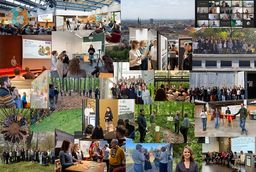From climate knowledge to climate-conscious action
- November 12, 2024
- 6 min. Reading time
There is widespread knowledge about climate change and its serious consequences. And yet urban and spatial design and our everyday actions are often not very climate-conscious. The OpenCultures Climate Future Lab aims to close this translation gap. In an interdisciplinary team, the laboratory is investigating how urban design and design decisions can encourage us all to act in a more sustainable and climate-conscious way. In this interview, OpenCultures spokesperson Prof. Tatjana Schneider talks about the importance of local presence and the goals of the Climate Future Lab.
Prof. Schneider, what is the research interest of the OpenCultures Climate Future Lab?
We want to investigate how the knowledge about the climate emergency that each and every one of us carries around with us can be translated into daily action. The messages of scientific publications on the effects of climate change have been very clear for a long time. We would therefore like to explore how this knowledge from research can be transferred to society. Through which channels and at what speed does this knowledge transfer of facts, figures and insights succeed? And how canwe, from a design research perspective, support the translation of this knowledge and make it manageable?
We have known for decades how far-reaching the consequences of climate change will be and we are constantly confronted with new heat records, record floods, etc. Forecasts even show that this development will continue to get worse. This is evidence that the measures to contain climate change are not yet having the desired effect, in our view. Therefore, we want to investigate how we can translate this knowledge into action. And we want to do this at the level of urban society. How can each individual translate this climate knowledge into sustainable living and what support do they need in doing so?
What role do design and urban design play in this?
Urban design contributes indirectly to how sustainably and climate-consciously we behave. The way we use the city, which form of mobility we choose, how we eat – these are all aspects that are influenced by the design of the space around us. These decisions have a major climatic influence. Here, design can help to make things simpler, lighter and more accessible, and to align them with planetary boundaries.
On the other hand, urban design also has a direct influence on the climate and how we deal with its consequences. For example, urban planning affects soil sealing, biodiversity and the consumption of finite resources.
Can I think of designing space in the same way as designing an aircraft cockpit? A pilot has the knowledge of how to fly an aircraft and the cockpit around them supports them in implementing that knowledge. So do we have the knowledge of what we need to do about climate change and our environment supports us in doing so?
Yes, exactly. We all know that the 1.5 degree target exists. We all know that it will be difficult to achieve this. We also know that around 45% of global CO2 emissions can be assigned to the construction industry in the broadest sense. This means, among other things, that we need different production and construction methods. There is a wealth of knowledge out there, but it is not being implemented. And not only in this area. The question we ask ourselves is why this knowledge is not being implemented and how we, as an urban society, can support the translation of knowledge into action. How this knowledge gap can be overcome has not yet been sufficiently researched.
Do you see this as just a knowledge gap or perhaps also a motivation gap?
That certainly plays a role, but it is more of a luxury discussion in the global North. We have not yet experienced the effects of climate change to the extent that other countries have long since felt them, where droughts and extreme weather events are already occurring much more frequently and dramatically than here. Nevertheless, it can be said that by designing spaces, behavioural patterns can be encouraged that make climate-conscious behaviour a matter of course.
With OpenCultures, you are building on the joint CO-Living-Campus project of the City of Braunschweig and Technische Universität Braunschweig. What was the focus of this project?
The CO-Living-Campus is designed as a climate-friendly neighbourhood for the common good. Over the last few years, ideas have been developed in collaboration with various stakeholders and have now been translated into urban development plans by architecture and planning firms. We want to build on the energy of this process, as well as on the established relationships, with OpenCultures.
What is the current state of the exchange with the residents in this neighbourhood?
Over the last year, ideas have been developed together with residents and users through lectures, events and workshops. We were able to get many people interested in the project and this future neighbourhood. These methods will continue to play an important role in the future.
What role has climate adaptation played in this?
The climate is very important to the people who took part in the workshops. Biodiversity and soil sealing are particularly important topics. At the moment, the area is heavily sealed. Many expressed the wish to counteract this heavy sealing in order to bring biodiverse spaces back into the city.
Will the Climate Future Lab also focus on other locations?
The CO-Living-Campus area is our starting point. However, we will not remain local, but will develop ideas and principles with our partners that can be tested or implemented in other places.
Climate-just design is a field that interests many people. We are in contact with potential partners from Scotland, Mexico, India and the United States. We will be holding summer and winter schools with these groups to exchange ideas. As I said at the beginning: what is missing are new ideas, stories, narratives and approaches to how we can counter climate change. This is being addressed by many laboratories and projects worldwide and we will be entering into dialogue with these groups and organisations.
What characterises the OpenCultures network?
We are a highly interdisciplinary team with colleagues from the humanities and social sciences, but also from the natural sciences. However, a unifying element is the basic assumption that we need less technologically oriented solutions and more changes in social and cultural practices to counter climate change.
In addition, we will work with civil society initiatives, cooperatives and other companies that are already applying climate knowledge. We can benefit from their experiences and, in return, network the various projects with each other to create an even greater leverage effect.
What will be the first steps of the Climate Future Lab?
We want to set up a place, probably on the grounds of the CO-Living-Campus, where we can work, meet and be responsive to the urban community – a place for formal and informal exchange. OPEN_CULTURES is not just a project, but also a specific place. My hope is that project participants can come together in this space to create synergies. This place is not just another university office, but also a neighbourhood meeting place where people can come by, get information and exchange ideas.
Have you already had experiences with this kind of participation?
Yes. My work in teaching and research in recent years has focused precisely on these areas, and I have repeatedly developed spaces for activities that go beyond classic research work to create situations and places for informal exchange. For example, we have worked together in gardening, cooking or cycling to create these spaces – which allows us to get into conversation with many people quickly and with very little effort.
Take, for example, the Quartier:Plus project at Schwarzenberg in the north of Braunschweig, which is also in our partnership network. The aim of the project is to shape community life in the neighbourhood. To this end, an empty shop was rented and converted into a central contact and meeting point. This not only makes visible the social synergies that can arise from such an impulse, but also the necessity of such critical infrastructure for negotiating new climate-just futures.
I think it's great that we are now able to implement this project, which, in addition to the rather theoretical examination of the translation of climate knowledge, is also moving resolutely out of the academic world. We are all very excited about this!
Thank you for the interview.
Contact

More Posts
All
Happy Holidays!
We wish everyone relaxing days, time to take a deep breath and a good start to the new year. We will be available again from 5 January.
1 min. Reading time
2025 Year in Review – The ZKfN Year in Pictures
2025 was marked by the expansion of the Climate Future Labs, new collaborations and a more closely networked climate community in Lower Saxony.
5 min. Reading time
How collaboration across disciplinary boundaries works
The workshop at the ZKfN symposium showed the prerequisites for interdisciplinary and transdisciplinary collaboration and the added value it creates.
3 min. Reading time